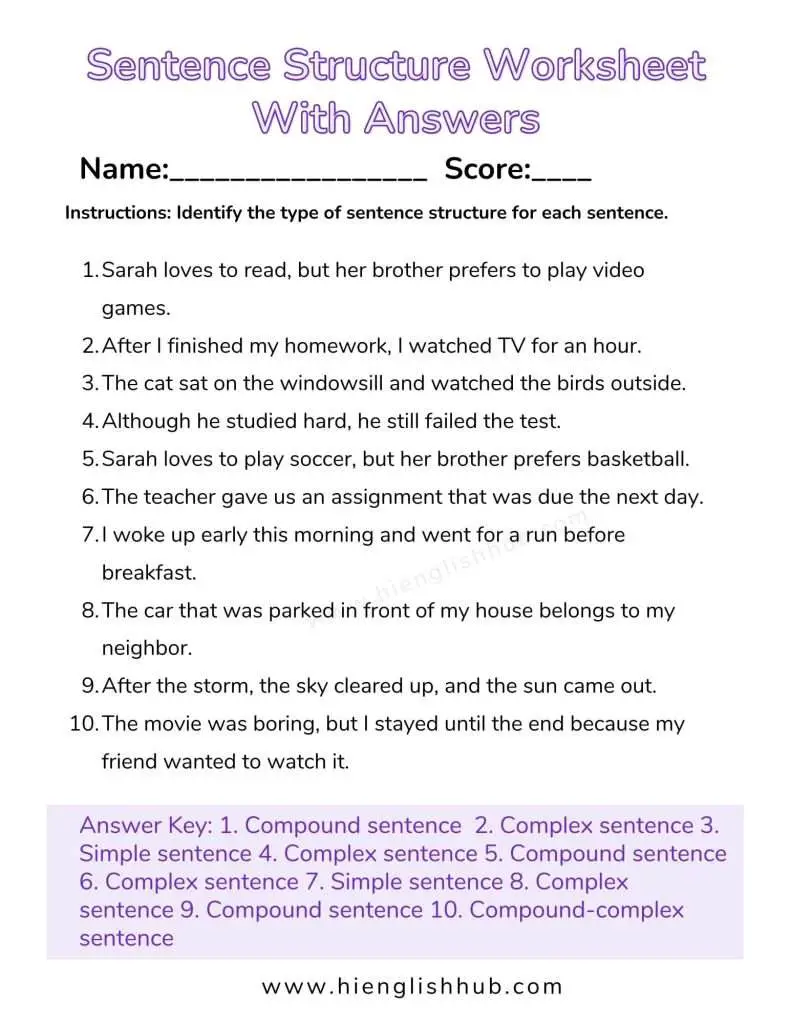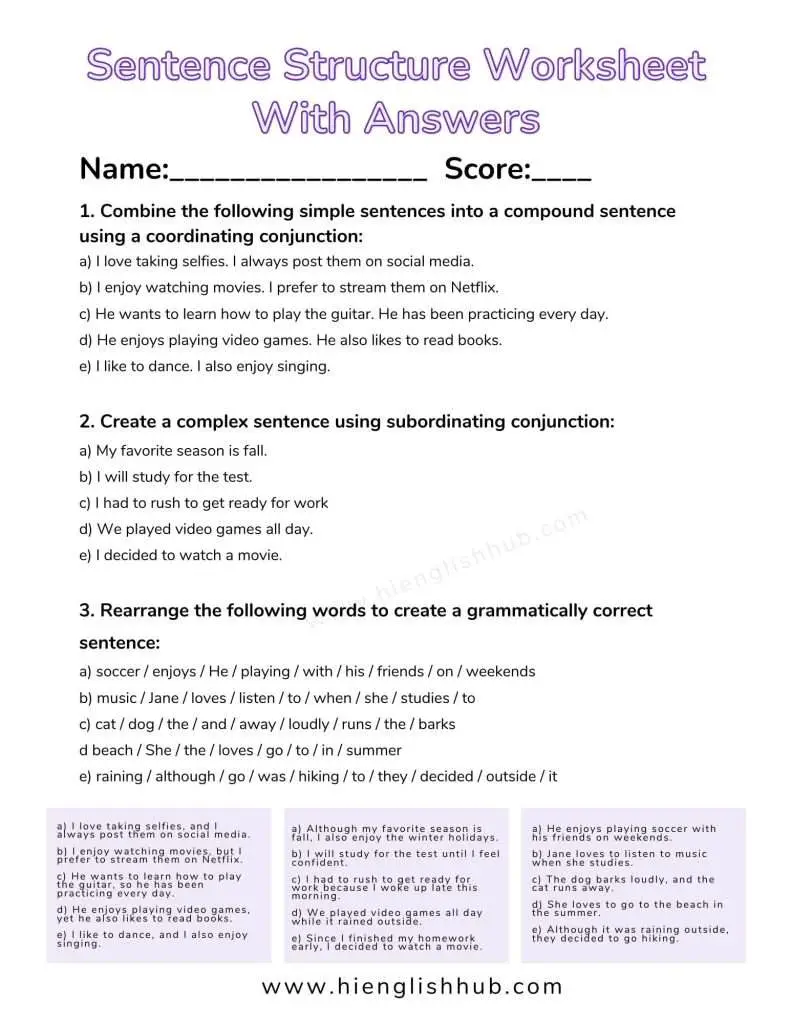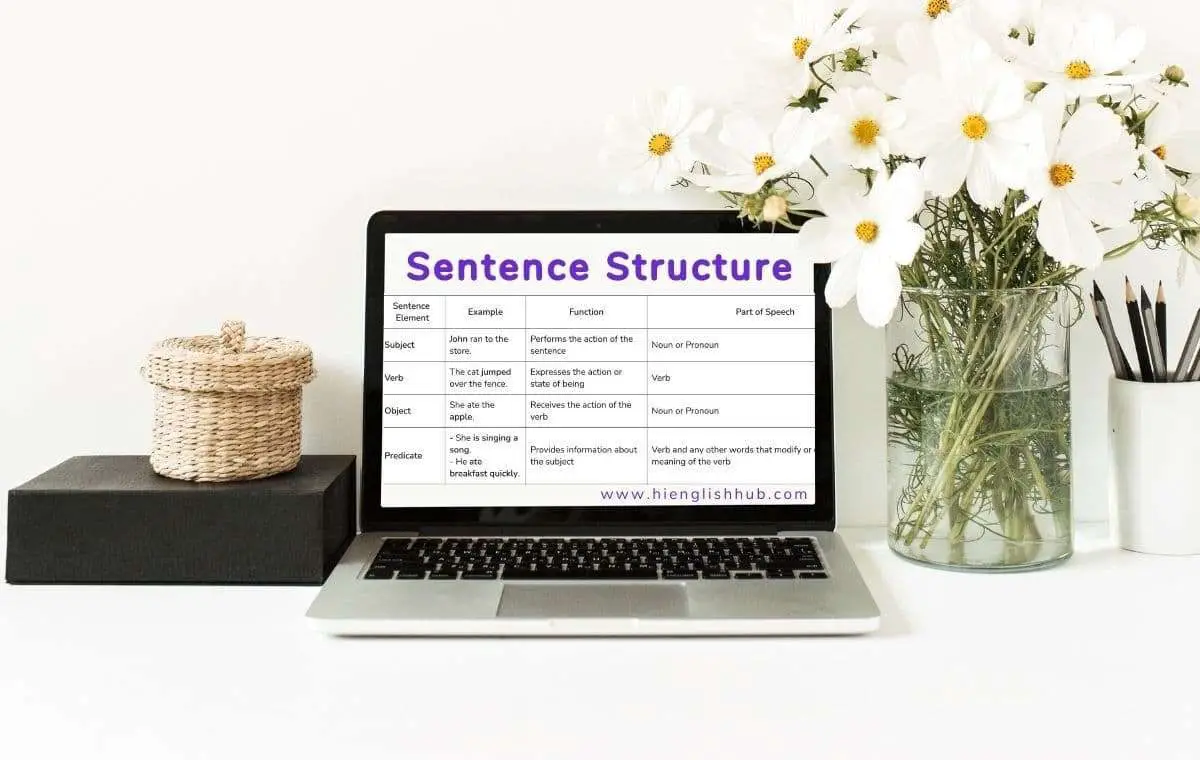Are you ready to learn about English sentence structure?
Whether you’re a native English speaker or an English language learner, understanding the basic elements of a sentence is crucial for effective communication.
In this blog post, I’ll cover
- the fundamental components of sentence structure,
- the different types of sentences,
- English sentence structure rules,
- the importance of sentence variety,
- and tips on how to improve your sentence structure.
Plus, you’ll have access to helpful worksheets to practice and test your knowledge of sentence structure.
Excited? Let’s get started!
What Is Sentence Structure?
Sentence structure is all about how we organize words to create meaning.
It’s like putting together a puzzle: every piece fits in a specific place to form a complete picture.
You might be wondering why sentence structure is such a big deal.
Why Is It Important?
Well, how you structure your sentences can greatly impact how effectively you communicate your ideas.
If your sentences are poorly structured, your message can become confusing or even unintelligible to your audience.
On the other hand, if you use effective sentence structure, you can ensure that your message is clear, concise, and easy to understand.
Now, let’s explore the basic elements of a sentence and the different types of sentences we use in English.
Basic Elements Of A Sentence
When it comes to understanding sentence structure, it’s important to start with the basics.
A sentence is a group of words that expresses a complete thought.
A sentence is made up of different parts, and each part has a specific function. The main parts of a sentence are the subject, verb, object, and complement.
Here’s a quick breakdown of what each of these elements means:
| Sentence Element | Example | Function | Part of Speech |
|---|---|---|---|
| Subject | John ran to the store. | Performs the action of the sentence | Noun or Pronoun |
| Verb | The cat jumped over the fence. | Expresses the action or state of being | Verb |
| Object | She ate the apple. | Receives the action of the verb | Noun or Pronoun |
| Complement | – They named the puppy Max. – The soup tastes delicious. | Provides extra information about the subject, object, or verb with words or phrases | Various parts of speech such as nouns, adjectives, adverbs, and prepositional phrases, among others. It depends on the type of complement being used, such as a subject complement, object complement, or verb complement. |
Types Of Sentence Structure
There are four main types of sentence structures based on their complexity:
- simple sentences,
- compound sentences,
- complex sentences,
- and compound-complex sentences.
A simple sentence is just that—simple! It contains one independent clause, meaning it has a subject and a verb and expresses a complete thought.
For example, “I posted a picture on Instagram.”
A compound sentence, on the other hand, contains two or more independent clauses joined by a semicolon or coordinating conjunction, also known as FANBOYS, like “for,” “and,” “nor,” “but,” “or,” “yet,” or “so.”
For example, “I posted a picture on Instagram, and my friend commented on it.”
A complex sentence has one independent clause and one or more dependent clauses, which means they cannot stand alone as complete sentences.
The dependent clauses are introduced by subordinating conjunctions like “when,” “because,” or “although.”
For example, “Because I wanted more likes, I posted a picture on Instagram.”
Finally, a compound-complex sentence is a combination of a compound and a complex sentence.
It contains two or more independent clauses and at least one dependent clause.
For example, “I posted a picture on Instagram, and my friend commented on it because she liked the filters I used.”
English Sentence Structure Rules
Sentence structure refers to the organization of words, phrases, and clauses in a sentence.
Here are some basic grammar rules for sentence structure:
- Capitalize the first letter of the first word when you start a sentence.
- When you write a sentence, usually start with the subject, followed by the verb, and end with the objects (S-V-O).
- The subject and the verb must agree in number.
If the subject is singular, the verb must be singular; if the subject is plural, the verb must be plural.
Example: He walks to school. (singular subject and singular verb)
They walk to school. (plural subject and plural verb)
- There are four types of sentences (declarative, interrogative, imperative, and exclamatory) that are classified based on their function.
Example:
1. Declarative – The dog is sleeping.
2. Interrogative – Is the dog sleeping?
3. Imperative – Let the dog sleep.
4. Exclamatory – The dog is sleeping!
- Proper punctuation is crucial to conveying the intended meaning of a sentence.
Commas, periods, colons, semicolons, and dashes are some of the most commonly used punctuation marks.
Example: My favorite food is pizza, but I also like tacos. (comma separates two independent clauses)
I love to travel; my favorite place is Paris. (semicolon separates two independent clauses)
When you finish a sentence, use a period, question mark, or exclamation point.
Sentence Variety
Using the same sentence structure over and over can make your writing sound boring and repetitive.
So, how can you achieve sentence variety?
One way is by using different sentence lengths. Short sentences can add emphasis and create a sense of urgency, while longer sentences can provide more detail and create a slower pace.
Another way is to use different sentence types, such as simple, compound, and complex sentences. Simple sentences are great for getting to the point quickly, while compound and complex sentences can add more detail and complexity to your writing.
Transitional words and phrases can also help create sentence variety by connecting ideas and creating flow between sentences.
Examples of transitional words and phrases include “however,” “in addition,” and “therefore.”
So, remember to mix it up when it comes to sentence length, type, and transitional words and phrases to keep your writing interesting and engaging!
How to Improve Sentence Structure
1. Read widely: Reading different types of texts can help you learn different ways of constructing sentences and using language.
2. Use sentence diagramming: Diagramming sentences can help you visualize the structure of a sentence and understand how the different parts relate to each other.
3. Practice writing exercises: Practice exercises can help you apply your knowledge and improve your sentence structure skills.
4. Get feedback on your writing: Feedback from others can help you identify areas for improvement and learn from your mistakes.
Sentence Structure Worksheets With Answers
If you want to improve your writing skills, check out these cool sentence structure worksheets!
They’re pretty handy and have sentence structure examples with answers, so you can practice and test your knowledge.

Instructions: Identify the type of sentence structure for each sentence.
1. Sarah loves to read, but her brother prefers to play video games.
2. After I finished my homework, I watched TV for an hour.
3. The cat sat on the windowsill and watched the birds outside.
4. Although he studied hard, he still failed the test.
5. Sarah loves to play soccer, but her brother prefers basketball.
6. The teacher gave us an assignment that was due the next day.
7. I woke up early this morning and went for a run before breakfast.
8. The car that was parked in front of my house belongs to my neighbor.
9. After the storm, the sky cleared up, and the sun came out.
10. The movie was boring, but I stayed until the end because my friend wanted to watch it.
- Compound sentence
- Complex sentence
- Simple sentence
- Complex sentence
- Compound sentence
- Complex sentence
- Simple sentence
- Complex sentence
- Compound sentence
- Compound-complex sentence

Instructions:
1. Combine the following simple sentences into a compound sentence using a coordinating conjunction:
a) I love taking selfies. I always post them on social media.
b) I enjoy watching movies. I prefer to stream them on Netflix.
c) He wants to learn how to play the guitar. He has been practicing every day.
d) He enjoys playing video games. He also likes to read books.
e) I like to dance. I also enjoy singing.
2. Create a complex sentence using subordinating conjunction:
a) My favorite season is fall.
b) I will study for the test.
c) I had to rush to get ready for work
d) We played video games all day.
e) I decided to watch a movie.
3. Rearrange the following words to create a grammatically correct sentence:
a) soccer / enjoys / He / playing / with / his / friends / on / weekends
b) music / Jane / loves / listen / to / when / she / studies / to
c) cat / dog / the / and / away / loudly / runs / the / barks
d beach / She / the / loves / go / to / in / summer
e) raining / although / go / was / hiking / to / they / decided / outside / it
a) I love taking selfies, and I always post them on social media.
b) I enjoy watching movies, but I prefer to stream them on Netflix.
c) He wants to learn how to play the guitar, so he has been practicing every day.
d) He enjoys playing video games, yet he also likes to read books.
e) I like to dance, and I also enjoy singing.
a) Although my favorite season is fall, I also enjoy the winter holidays.
b) I will study for the test until I feel confident.
c) I had to rush to get ready for work because I woke up late this morning.
d) We played video games all day while it rained outside.
e) Since I finished my homework early, I decided to watch a movie.
a) He enjoys playing soccer with his friends on weekends.
b) Jane loves to listen to music when she studies.
c) The dog barks loudly, and the cat runs away.
d) She loves to go to the beach in the summer.
e) Although it was raining outside, they decided to go hiking.
Sentence Structure: FAQ
Let’s answer some common questions about sentence structure that you might have!
What Are 4 Types Of Sentence Structure?
The four types are simple, compound, complex, and compound-complex sentences.
What Are The 5 Rules Of Sentence Structure?
There aren’t exactly five rules, but some important things include using proper punctuation, avoiding run-on sentences, using a variety of sentence types and lengths, and making sure the subject and verb agree.
Final Thoughts On Sentence Structure
So there you have it, some important things to remember about sentence structure.
Always aim to make your writing clear and easy to read by using a variety of sentence types and lengths.
Don’t forget to proofread and edit your work to avoid common mistakes.
And most importantly, practice, practice, practice!
If you found this information helpful, share it with your friends and follow me on Pinterest and Twitter for more writing tips and tricks.


